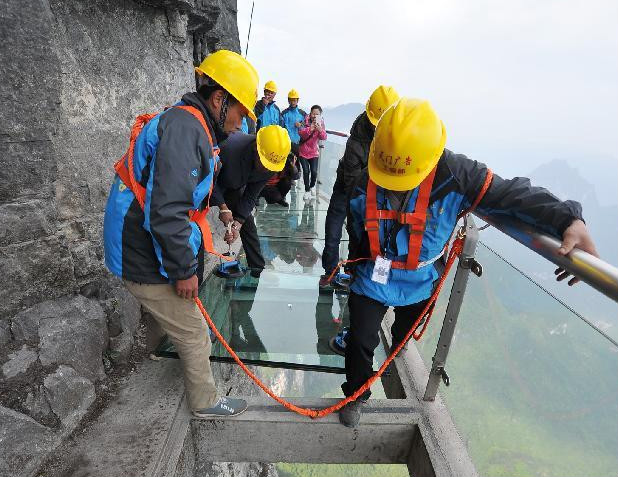Report: TFP vital to tourism development in China

Workers carry out routine maintenance on the glass skywalk at the Tianmen Mountain National Park.
The growth of the tourism industry in China has been mostly motivated by the input of labor and capital, while the promotion of efficiency in tourism contributed less to its development, according to the Green Book of China’s Tourism No. 15 recently released in Beijing.
Compiled by the Tourism Research Center under the Chinese Academy of Social Sciences, the green book suggests that China’s tourism development primarily depends on traditional impetus, and it should resolve three major problems in future development.
First of all, China’s tourism in the future should be less labor-intensive. According to the green book, China’s labor population aged between 15 and 59 peaked at 940 million in 2010, and it is predicted to drop to 910 million by 2020. Accordingly, the proportion of the working-age population will drop from about 70 percent to 60 percent.
Tourism in China created about 5.2 percent of China’s jobs in 2003, and the number increased to 10.2 percent in 2014, according to the report. About 7.5 million jobs will be created annually from 2014 to 2020, and tourism will create 14 percent of the nation’s jobs by 2020. However, labor costs are rapidly rising, and labor shortages will soon emerge.
In this context, meeting the demand for labor will pose a significant problem for the long-term sustainable development of tourism. The green book suggests that a less labor-intensive model of tourism in the future will be ideal.
Over the next few years, the industry should increase labor efficiency in tourism and improve the application of technology and intelligence in tourism, according to the report. The report suggests that technologies, including the Internet, cloud computing, Big Data, robots and virtual reality, will be the key to the sustainable development of modern tourism.
Increasing the efficiency of investment in tourism is another problem. The investors are currently from industries of traditional tourism, Internet, business, real estate, manufacturing and energy, and such models as Public-Private Partnership, distinctive counties and region-based tourism also emerged.
The green book suggests that the lack of a mechanism to assess the efficiency of investment makes it difficult for investment to meet demand. Homogeneous, low-price and monopolistic competition has reduced the average benefit and efficiency of the industry.
Although generally there is still space for growth of capital input, the efficiency of investment remains to be seen. And the overreliance on the continuous input of capital will also reduce the marginal returns of investment. The green book suggests addressing such problems by rationally guiding investment and supply, enhancing market adjustment, preventing risk, and improving efficiency.
Last of all, raising efficiency should play a more significant role in driving tourism. The green book suggests that the annual growth rate of Total Factor Productivity (TFP) from 2005 to 2012 was 0.2 percent. Tourist enterprises generally face the pressure of competition and inadequate profit.
China should establish a new market system, industrial macroeconomic regulation and comprehensive innovation in tourism. A resource-allocation mechanism should be established and the growth pattern should focus on efficiency, relying on integrated innovations in patterns, technology, policies and capital utilization, according to the green book.
